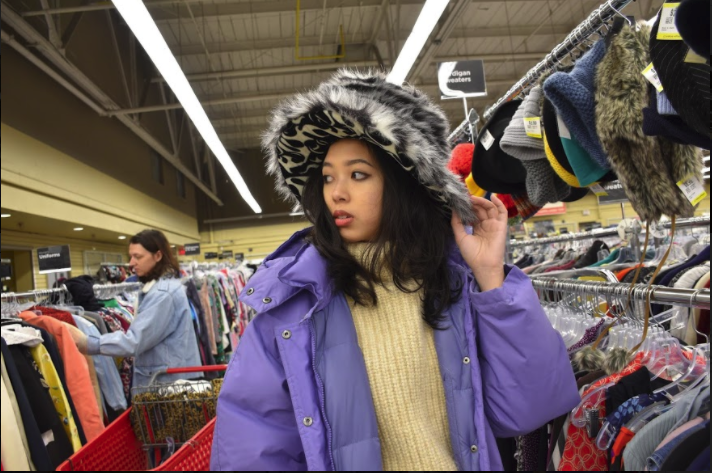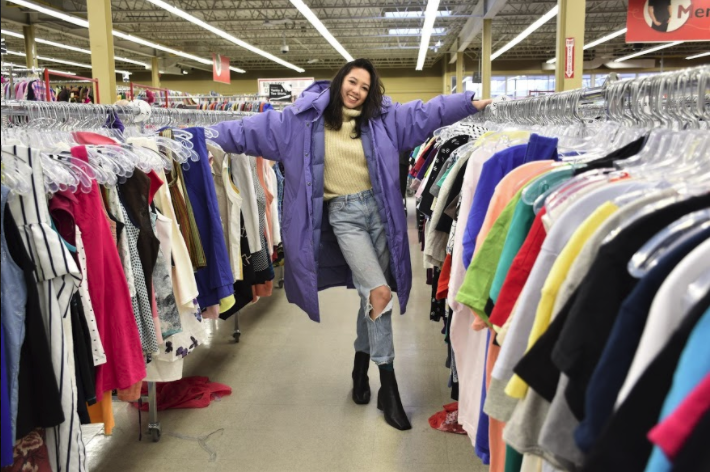
Lilia Smichenko |
Nicky Nguyen was in the Black Market, a thrift store in Downtown Toronto, searching through clothing, trying to find another treasure to add to her wardrobe.
It might seem overwhelming for someone who has never been to this store before, but certainly not for Nguyen.
She knew they had 50 per cent off that day, so she might save even more than usual, and for a student like herself, what could be better.
There it was, hanging with other coats in the outwear section – a fur coat caught her eye. It was leather on the inside with soft brown fur on the outside. She looked at the price, $40.
More than she would usually spend on a thrift find, but then she remembered that it was 50 per cent off, and at that moment, it was sold.
“It turned out to be my habit, I stopped buying new clothes. It just feels great to find good stuff with a good price,” Nguyen says.
Many young people have insecurities about what to wear to make an impact. While the state of the planet’s climate health is declining, young people thrift shop to make a fashion statement and help the environment.

Village. [Credit: Lilia Smichenko]
According to an article from TIME magazine, we were thrifting for centuries, exchanging clothes and stuffing chairs with worn-out items that we could no longer wear.
However, the prejudice started in the 19th century when a rumour was spread about a girl who got smallpox from a dress she bought in a Jewish resale shop.
The first thrift shop stores opened in the 1920s for the same purposes as Goodwill and Salvation army.
With the rise of social media and influencers, thrifting has gained popularity. Instagram and YouTube bloggers started to showcase the alternative shopping and unique secondhand clothes they found.
This is how Nguyen, and many others, got into this lifestyle. When she was 16, she started to watch YouTube bloggers, who were showcasing all these great finds for low prices. That’s when it all clicked.
“[Kia Marie] brought out the idea of like, ‘Oh, this is cool,’ and she has a lot of cool stuff that you cannot find anywhere else. From that time, I haven’t bought any new clothes,” Nguyen says.
She started thrifting in 2015, and since then, the only thing she buys at retail stores is shoes. Eighty per cent of her wardrobe is reused clothes. Yet, she didn’t stop there.
She also likes to buy home décor such as frames and paintings that add to her unique style. The only thing that stops her from buying even more, is not having a car.

[Credit: Lilia Smichenko]
While she buys everything she can get her hands on in thrift stores, some people think the culture surrounding thrifting isn’t all positive.
Andrea Olive, an associate professor of Political Science and Geography at the University of Toronto, thinks thrift shops feed people’s consumerism and allows them to overbuy because of all the clothes people donate to thrift shops.
As an environmental researcher, Olive has her own way of dealing with reducing waste; she decided to stop buying any clothes in 2020, and will only buy basic stuff like food. To aid her in this, she plans to quit social media.
“For me, this is about the environment. I’m doing it for environmental reasons,” Olive says.
Quitting social media might sound crazy to some people, let alone being less consumeristic. The owner of The House of Vintage in Toronto, Dennis Adamidis, thinks that a lot of people, himself included, like to mix new clothes with secondhand.
“I don’t do all vintage. I think it’s too costumy. It’s not my style, but you get to express yourself and have your own style,” Adamidis says.
He thinks that thrift shopping isn’t associated with being poor anymore, it’s about finding your own style and expressing it your way.
Adamidis says that even celebrities come to his vintage store for unique clothes, instead of buying expensive brands.

clothing at Value Village. [Credit: Lilia Smichenko]
No matter what your reasons for thrift shopping are, whether it’s to reduce the waste, stand out or just shop on a budget. Nicky shared some tips, based on her five-year thrifting experience.
• It will take time to go through everything. Nguyen suggests finding colours you like.
• Follow stores like the Black Market and Common Sort, on Instagram to keep yourself updated on arrivals and store discounts.
• Nguyen suggests specifying how much money are you willing to spend and stay focused on it, that way you won’t buy something you don’t need and will stay on budget.
So go ahead and find that leather jacket of your dreams, super cheap and what’s more important eco-friendly.